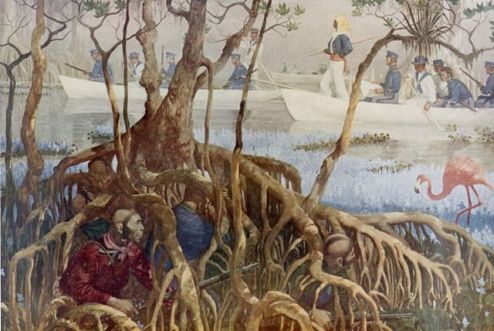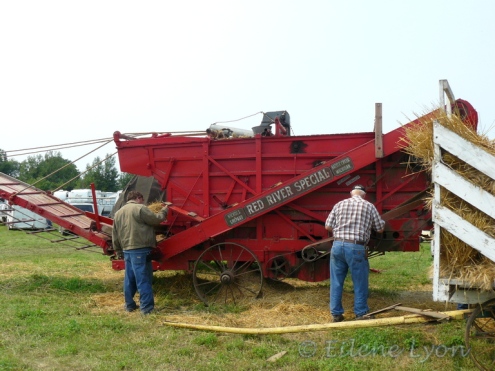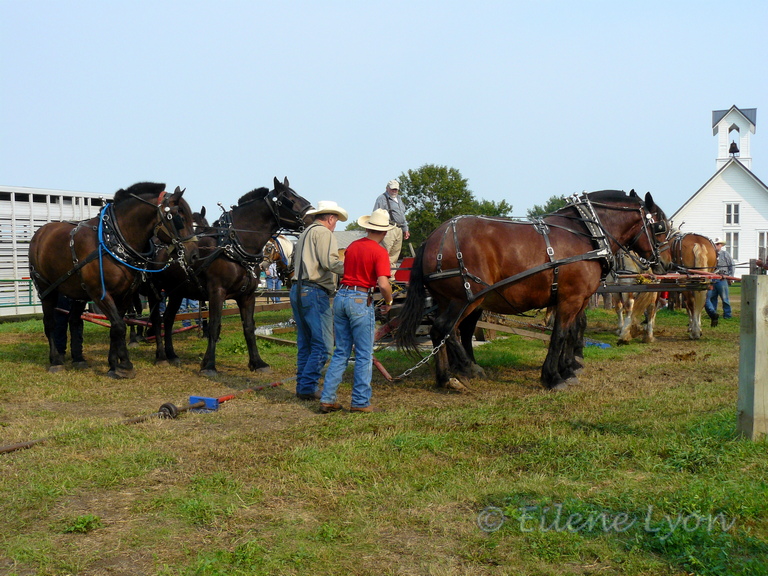Week 9: #52 Ancestors – Multiples
By Eilene Lyon
“Mr. Weston – It seems to be concluded that late keeping apples are a desideratum for California cultivation, our long dry seasons prematurely ripening the varieties usually keeping well in northern latitudes. I have late keeping varieties, acclimated to southern latitudes…which you will please test as to their quality.” Charles Mock – June 14, 1859 in a letter to the Sonoma County Journal
My 3rd great-grandmother, Christina (Mock) Davis Cooke, had seven brothers. Their parents were David and Elizabeth (Hoover) Mock of Davidson County, North Carolina. The Mocks moved to Lafayette County, Missouri, in the 1830s. Four of the seven Mock brothers ended up in Sonoma County, California, in the mid-19th century.
Two of the brothers (both single), Wesley and his older brother, William, headed to California from Missouri with the 49ers. They spent three years mining on the Feather and Yuba Rivers, though they did return to Missouri in 1850.1
The two “Gold Hunters” were enumerated in Missouri in the 1850 census, taken in October.2 Presumably, they decided to put their affairs in order to move to California permanently.


Wesley and William relocated to Sonoma County in 1853 to take up farming. Two more brothers joined them there soon after. Charles, the eldest of the Mock children, brought his family all the way from North Carolina. He and his wife had been running a school for girls back east, but Charles was also a committed agriculturalist, running a nursery and orchard.3 He brought fruit trees with him to the west coast.
The last of the four brothers was John Lewis Mock. He moved to Missouri with his parents when he was 19 years old. Like Charles, he brought a wife and children to Sonoma County. He continued his work as a farmer and was very active in the local grange. He also had a nursery selling fruit trees.4

John was actually in California when the 1850 census taker came around to his home in Missouri, but they enumerated him with his family anyway.5 History books don’t mention him traveling west with Wesley and William, but he may have. More likely, he went to California to take over his brothers’ claims so they could go to Missouri for the winter.
All four brothers, and their wives and children, became well-known in the Petaluma and Santa Rosa areas. Their longevity earned William and Wesley biographical notes in local history books. William’s life story has some items of particular interest.
In 1832, he became a cadet at West Point, where he studied engineering and was graduated in 1836. He also developed his skills as a portrait artist.6 Upon graduation, he began writing a diary of his travels that included a visit to his parents and siblings at their new land in Missouri – they hadn’t yet finished their log cabin. While there, he received a 2nd Lieutenant commission to serve in the Seminole War in Florida.7
“About the first of September a communication from the war department reached me embracing a brivet 2nd Lieutenant commission and orders to report for duty by the 30th inst. I accepted the commission and on the 14th inst set out to join my regiment.” – William Mock Diary 1836

” — Department of Defense, U.S. Marine Corps (Photo #: 306073-A) (Wikimedia Commons)
Tiring of military service, at the rank of Captain, he handed in his resignation to his superior, William T. Sherman, in 1841 and returned to Missouri.8 He served as the Lafayette County surveyor until heading to California.
In Sonoma County, William turned his engineering skills to good use, inventing a horse-powered hay baling machine in 1865. It operated much like a threshing machine.9
It appears that all the Mock brothers made notable contributions to the development of agriculture in Sonoma County. They also served in a variety of civic roles. I do have to wonder what their farm lands would be worth today. Probably more than the gold they found!
Did any of your relatives go to California in the gold rush? What have you learned about them?
 Feature image: These draft horses are preparing to power a threshing machine (below). They will march in a circle and a series of gears will turn the drive shaft seen lying on the ground. Another series of gears at the threshing machine operate it in the place of steam power. Taken at Prairie Village near Madison, South Dakota. (E. Lyon 2015)
Feature image: These draft horses are preparing to power a threshing machine (below). They will march in a circle and a series of gears will turn the drive shaft seen lying on the ground. Another series of gears at the threshing machine operate it in the place of steam power. Taken at Prairie Village near Madison, South Dakota. (E. Lyon 2015)

Note: The impetus for this blog post came from a news report last week in the New York Times that informed me of the terrible grizzly bear mauling death of 40-year-old Charles W. Mock IV. I don’t know if/how this unfortunate man is related to my Mock ancestors (it’s not an unusual name), though both lines go back to Rowan County, NC. I extend my sincere condolences to his family.
John L. Mock of Petaluma, Sonoma County, had a son named Charles Wesley Mock who died in Tacoma, Washington, in 1898, as a result of a bicycle collision (he on one bike, a woman on another). He is not in the line of Charles W. Mock IV above. The family use of the name Wesley may stem from their connection with the Methodist Church.
- Gregory, Tom. 1911 History of Sonoma County, California, With Biographical Sketches… Historic Record Company, Los Angeles, pp. 426, 1046. ↩
- William Mock and Wesley Mock. Year: 1850; Census Place: District 46, Lafayette, Missouri; Roll: 403; Page: 232b – via Ancestry.com. ↩
- https://www.findagrave.com/memorial/145289218/charles-mock ↩
- “Fruit Trees.” Petaluma Argus, December 17, 1861, p. 2 – via Newspapers.com. AND “Petaluma Grange.” Petaluma Weekly Argus, February 25, 1876, p. 3 – via Newspapers.com. ↩
- John L. Mock. Year: 1850; Census Place: District 46, Lafayette, Missouri; Roll: 403; Page: 244a – via Ancestry.com. ↩
- Gregory, p. 1045. ↩
- William Mock Diary 1836-1841. Transcription by Barbara Webster, posted on Ancestry.com. Original in the collection of United States Military Academy (West Point). ↩
- https://penelope.uchicago.edu/Thayer/E/Gazetteer/Places/America/United_States/Army/USMA/AOG_Reunions/31/William_Mock*.html ↩
- “Mock’s Roller Hay Press.” Petaluma Weekly Argus, July 13, 1865 p. 2 – via Newspapers.com. ↩

I really enjoyed this post—it is such an amazing and interesting slice of American history.
LikeLiked by 2 people
It was a fun discovery. I didn’t even have some of these men in my tree when I started researching the story. Of course this is only one little piece of their lives, as we discussed yesterday.
LikeLiked by 2 people
Of course! But you really were able to find some amazing details.
LikeLiked by 1 person
Newspapers and that diary was a wonderful find. The woman who transcribed and posted it on Ancestry wasn’t even a blood relation to William. He married late in life to a widow with a daughter. The daughter died young and the diary passed down through her husband’s family. He describes his parents’ land in Missouri (my 4th great-grandparents) and oddly, it is not the land that they bought from the government a couple years later.
LikeLiked by 1 person
It’s great that someone preserved it. Many people would have just thrown it away. 😦
LikeLiked by 1 person
Especially since he wasn’t really a relative by blood! I think she did the right thing by donating it to West Point.
LikeLiked by 1 person
My family didn’t start arriving in America till the 20th century and they stayed on the East Coast. As far as I know…
LikeLiked by 1 person
Were they coming to meet some relations who had migrated earlier? Where were they from?
LikeLiked by 1 person
My great grandmother came over with her husband from Italy.She was like 15. They settled in Worcester Mass and I think they knew one person. My grandfather was five with his parents, (Italy) and I think they knew one person. My other grandparents (Poland) were born here…I think their parents maybe had a cousin or something
LikeLiked by 1 person
I think it would be cool to have more recent family connections to Europe. Have you ever met any Italian relatives?
LikeLiked by 1 person
No. I know my relatives that emigrated here didn’t want any part of the “old country” and didn’t keep in touch with those who chose to not come to America.
LikeLiked by 1 person
Hmm. That’s too bad. I’d be nosy and try to find them. The genealogist in me!
LikeLike
😉
LikeLiked by 1 person
Wesley Mock certainly lived a very interesting and accomplished life! My family is strictly East Coasters (to the best of my knowledge). The migration in my maternal grandmother’s line was from Nova Scotia to Massachusetts. The big western migration in my maternal grandfather’s line was from Hampton to Kensington to Candia, NH–a distance of all of about 30 miles!
LikeLiked by 3 people
I do come from people on the move – many adventurous sorts in me tree. I think from North Carolina to Missouri to California in one generation is unusual. Most people who went to California in the gold rush originally had no intention of staying there. Four brothers all making it their permanent home from the 1850s has to be very rare.
LikeLiked by 3 people
Adventurous ancestors make for very interesting research and writing of family history!
LikeLiked by 1 person
They do, indeed!
LikeLike
My mom’s family came to the US in the 19th century and some of them settled in St. Louis, Missouri, where I sprouted up. (My dad’s family had been here since Colonial days, all from the South.) My brother and I both lived in the Bay Area for awhile as adults and my parents even bought a condo in SF, but they sold it after a few years. I’m sad about that. The weather and views in the Bay Area can’t be beat!
LikeLiked by 2 people
I think a lot of the argonauts were pleased with the climate and scenery once they got to California.
LikeLiked by 1 person
Sorry to hear of Mr. Mock’s demise by grizzly bear. To think if you hadn’t read that, we may not have had the opportunity to read this interesting piece. I love reading about all the amazing things ordinary folks have done in their lives. William was certainly multi talented, from portrait artist to inventor! I haven’t any ancestors in North America. Our family immigrated in the 1960’s, so no gold seekers heading to the Yukon, although I did eventually end up there!
LikeLiked by 1 person
Wow! Where is your family from? What took you to the Yukon?
LikeLiked by 1 person
We came from Scotland. I took a teaching job up there. Loved the Yukon, but other circumstances brought us back south. .
LikeLiked by 2 people
Is there anything similar between Scotland and Yukon (landscape-wise that is)?
LikeLiked by 1 person
They are both mountainous, I think Newfoundland’s landscape might have a little more in common.
LikeLiked by 1 person
A delightful post, and so is the feedback.
LikeLiked by 1 person
Thanks, Joy. I never know what will resonate.
LikeLiked by 1 person
I agree. I guess it’s just our job to get it written and shared, then see where it connects. Synchronicity
LikeLike
You sure have a lot of movers and shakers in your family! Fascinating!
LikeLiked by 1 person
I am constantly surprised at what my research turns up!
LikeLiked by 1 person
It really is amazing.
LikeLiked by 1 person
I’m pretty sure if you dig just a little deeper, your ancestors were the ones who invented the Jeep. They truly were adventurous folk.
LikeLike
The mocks sound like good people, who did well, all things considered at the time.
I have a great uncle who went west long after the gold rush days, in the early 1900s, hoping to be a cowboy. He died in a copper mining accident in AZ and that’s all I know about any relative on mine who went west. Your ancestors were much more courageous than mine. Hence all the cool stories!
LikeLiked by 1 person
Thanks, Ally. That’s a shame about your great uncle. Mining like that was soooo dangerous, especially in those days.
I do find some adventurous souls in the tree, when I wander out into the tiny branches.
LikeLiked by 1 person
Fascinating!! The California Gold Rush is actually one of my favorite periods to read about. What a unique family tie you have to this. No Gold Rushers in my family that I know about – other than me striking out for California for those golden sunsets and coastal views 🙂 🙂
LikeLiked by 1 person
Well, that’s probably a better kind of gold to seek out anyway!
LikeLiked by 1 person
What an interesting story you’ve uncovered here Eilene. I had no adventurous relatives who went to California for the Gold Rush, but that’s likely due to my Canadian heritage. I was born in Canada and lived there until 1966 when our family moved to the U.S. My relatives, now all deceased, never strayed too many miles from the town they were born in (Ariss, Ontario). The size of those draft horses – no wonder they did their jobs so effortlessly!
LikeLiked by 1 person
California drew people from all over the world. It was quite astonishing how far they came from. I can’t seem to find too many on my tree who liked to stay put.
LikeLiked by 1 person
I didn’t realize the Gold Rush drew folks from all over the world. I remember studying about it in school, but that was many years ago. I’ve got a boring tree – my maternal ancestors, all born on a farm and as soon as they were old enough, moved out, got a small farm and a wife and never strayed more than a few miles from their birthplace. My grandmother and her sister were considered “radical” as they left that town and moved to “the Big City” a/k/a Toronto.
LikeLiked by 1 person
Yep, it was the largest mass migration up to that time. Europe, South America, Asia, Australia, just about every place. Well, nothing wrong with farming and making a place tour own for generations.
LikeLiked by 1 person
That’s amazing about a migration that large. Farming was in their blood and my mom would tell me her parents would take the last two weeks of August off to help bring in the crops at each of the farms as well as their neighbors – everyone pitched in, even the kids had their tasks. I would like to live in a community like that.
LikeLiked by 1 person
My Dad’s parents grew up in a community like that in South Dakota. It does have its appealing aspects!
LikeLiked by 1 person
Just a little more modern than the “Little House on the Prairie” days but the same ambiance!
LikeLiked by 1 person
Great research 🧐 and what a beautiful 🤩 working horses 🐴!! The number of kids you mentioned reminded me about the current situation… it’s very rarely a family is ready to welcome & take care about 7-8 kids nowadays. I honestly can’t imagine even having 4-7 siblings 😅😅
LikeLiked by 1 person
I think farming and big families really went together fairly well.
Those draft horses were absolutely gorgeous. I took a bunch of photos of them. Magnificent animals.
LikeLike
The interesting story covered! Great Research..Good read
LikeLiked by 1 person
Thank you!
LikeLike
wow quite the story. those are so fine horses
LikeLiked by 1 person
Thanks, Kelly. I’ve always admired draft horses. I saw the Budweiser Clydesdales in a parade once and marveled at their size!
LikeLike
Just finished transcribing 28 pages of Lt. William Hoover Mocks 2nd Seminole War Journal. Extremely interesting and articulate account. We were able to get portions handed down (some still in pencil) from ancestor Elizabeth, William’s sister. Do you have any parts of the journal?
LikeLiked by 1 person
I am still missing 25th March 1837 to 31st October 1837, and anything after 9th July 1838. I have 15th June 1836 to 24th March 1837 – and 1st November 1837 to 9th July 1838.
LikeLiked by 1 person
Carl, Thanks so much for commenting. Aside from the portion posted on Ancestry (as noted in the sources), I have not seen, nor do I have any of William’s diaries. I’ll have to go back and look at the dates covered in that portion. Do contact me through my blog’s contact page, please. I’d love to learn more about our family connection.
LikeLike